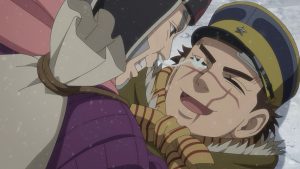 It’s pretty much a regular occurrence to watch an episode of this show and say “yeah, that could only happen in Golden Kamuy“. What strikes me most is that GK pulls off stuff other shows can’t, making it look effortless while they’d fail miserably by looking like they were trying too hard. What’s the secret behind that? One may as well ask how alchemists turn iron into gold (hint: no one can, because they can’t). But Noda-sensei’s total fearlessness as a writer may have a fair amount to do with it. If indeed there’s stuff on the cutting room floor that he deemed was too outrageous, I shudder to think what it might be.
It’s pretty much a regular occurrence to watch an episode of this show and say “yeah, that could only happen in Golden Kamuy“. What strikes me most is that GK pulls off stuff other shows can’t, making it look effortless while they’d fail miserably by looking like they were trying too hard. What’s the secret behind that? One may as well ask how alchemists turn iron into gold (hint: no one can, because they can’t). But Noda-sensei’s total fearlessness as a writer may have a fair amount to do with it. If indeed there’s stuff on the cutting room floor that he deemed was too outrageous, I shudder to think what it might be.
 This magnificent season has mostly been about drawing the world inside the story apart, including the most important link in that story, Sugimoto and Asirpa. As I noted a couple of weeks ago Noda actually made the plot come together even as he’s spread out his cast, a great feat of writing. But as we approach the end of the third cour things go into reverse, and the season ends by bringing not quite everyone but a lot of that cast back together. It happens on the ice floes between Karafuto and Hokkaido, and it’s about as dramatic as anyone could ask for.
This magnificent season has mostly been about drawing the world inside the story apart, including the most important link in that story, Sugimoto and Asirpa. As I noted a couple of weeks ago Noda actually made the plot come together even as he’s spread out his cast, a great feat of writing. But as we approach the end of the third cour things go into reverse, and the season ends by bringing not quite everyone but a lot of that cast back together. It happens on the ice floes between Karafuto and Hokkaido, and it’s about as dramatic as anyone could ask for.
 That “almost everyone” includes Svetlana, the daughter of the lighthouse keepers who was Sofia’s cellmate at Ako Prison. Svetlana doesn’t seem terribly important in the larger plot, but her presence offers a spotlight to Tsukishima’s humanity, as he risks everything he’s worked towards in order to try and convince Svetlana to go back to her parents. Chaos is descending, as the blizzard worsens (this series has become astonishingly good at depicting bad weather), escaped convicts fan out across the ice, and the paths of allies turned enemies are rapidly converging. But Tsukishima still does what he does, because it’s true to his nature.
That “almost everyone” includes Svetlana, the daughter of the lighthouse keepers who was Sofia’s cellmate at Ako Prison. Svetlana doesn’t seem terribly important in the larger plot, but her presence offers a spotlight to Tsukishima’s humanity, as he risks everything he’s worked towards in order to try and convince Svetlana to go back to her parents. Chaos is descending, as the blizzard worsens (this series has become astonishingly good at depicting bad weather), escaped convicts fan out across the ice, and the paths of allies turned enemies are rapidly converging. But Tsukishima still does what he does, because it’s true to his nature.
 I think this incident is important in the sense that Noda’s characters are so charismatic that we can tend to admire even the wicked ones so much that the line between good and evil gets very blurry. Men like Sugimoto, Tsukishima and Tanigaki are not the same as men like Ogata and Kiroranke and Tsurumi, and it’s important in climactic moments like this that we be reminded of that fact. Of course Kiroranke and Tsurumi would at least be able to honestly claim that (in their own minds) they were committing evil acts in the cause of good. Ogata is a different beast altogether.
I think this incident is important in the sense that Noda’s characters are so charismatic that we can tend to admire even the wicked ones so much that the line between good and evil gets very blurry. Men like Sugimoto, Tsukishima and Tanigaki are not the same as men like Ogata and Kiroranke and Tsurumi, and it’s important in climactic moments like this that we be reminded of that fact. Of course Kiroranke and Tsurumi would at least be able to honestly claim that (in their own minds) they were committing evil acts in the cause of good. Ogata is a different beast altogether.
 Both Kiroranke and Ogata have seemed increasingly predatory towards Asirpa over the course of this season, in different ways. Here we see Ogata at his most craven, most venal, most stone-cold villainous. He has no greater cause – rather, he seems to resent life itself, and anything that brings light to it. His efforts to manipulate Asirpa were chilling, though I would argue perhaps no more so than what we’ve been seeing from Kiroranke all season. Thank the Kamuy that Asirpa is the sharp girl she is, and she trips up Ogata (monkfish stew) in his attempts to wring her revelation out of her by selling her a fictionalized account of his shooting of Sugimoto and her father at Abashiri.
Both Kiroranke and Ogata have seemed increasingly predatory towards Asirpa over the course of this season, in different ways. Here we see Ogata at his most craven, most venal, most stone-cold villainous. He has no greater cause – rather, he seems to resent life itself, and anything that brings light to it. His efforts to manipulate Asirpa were chilling, though I would argue perhaps no more so than what we’ve been seeing from Kiroranke all season. Thank the Kamuy that Asirpa is the sharp girl she is, and she trips up Ogata (monkfish stew) in his attempts to wring her revelation out of her by selling her a fictionalized account of his shooting of Sugimoto and her father at Abashiri.
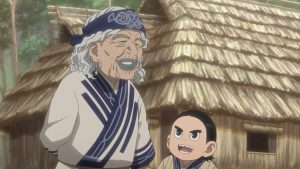 Meanwhile, Tanigaki and Kiroranke stumble onto each other on the ice, and things go down so quickly that it’s almost dizzying. I found myself wavering over who to root for here, wanting neither man to die, which is a testament to how good Noda is at making his bad characters likeable. Neither emerges from this tussle remotely unscathed, and though Kiroranke seemingly got the worst of it (an Ainu dagger in the gut) he’s the one who’s able to walk away, leaving a trail of blood for Lt. Koito and Tsukishima to follow. Kiroranke is also able to lay a bomb trap for them, which wounds both, Tsukishima more seriously, and pisses the hell off out of Koito.
Meanwhile, Tanigaki and Kiroranke stumble onto each other on the ice, and things go down so quickly that it’s almost dizzying. I found myself wavering over who to root for here, wanting neither man to die, which is a testament to how good Noda is at making his bad characters likeable. Neither emerges from this tussle remotely unscathed, and though Kiroranke seemingly got the worst of it (an Ainu dagger in the gut) he’s the one who’s able to walk away, leaving a trail of blood for Lt. Koito and Tsukishima to follow. Kiroranke is also able to lay a bomb trap for them, which wounds both, Tsukishima more seriously, and pisses the hell off out of Koito.
 Noda displays all his brilliance in the final (for now) showdown between Asirpa, Ogata and the freshly-arrived Sugimoto. Ogata is such a warped soul that I genuinely believe he wanted Asirpa to kill him, just for the pleasure of knowing it would break her. But Sugimoto pulling the arrow out of his eye and sucking the poison out – that was next-level stuff. Horrifying, poetic, beautiful, ironic – it was an incredibly powerful moment (as was their reunion immediately afterwards). Sugimoto’s love for Asirpa and, perhaps even more, his desire to shield her from the corrupting influence of the world (and men like Ogata) is surely the purest and most powerful thing in Golden Kamuy.
Noda displays all his brilliance in the final (for now) showdown between Asirpa, Ogata and the freshly-arrived Sugimoto. Ogata is such a warped soul that I genuinely believe he wanted Asirpa to kill him, just for the pleasure of knowing it would break her. But Sugimoto pulling the arrow out of his eye and sucking the poison out – that was next-level stuff. Horrifying, poetic, beautiful, ironic – it was an incredibly powerful moment (as was their reunion immediately afterwards). Sugimoto’s love for Asirpa and, perhaps even more, his desire to shield her from the corrupting influence of the world (and men like Ogata) is surely the purest and most powerful thing in Golden Kamuy.
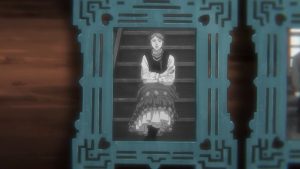 The real kicker, though, is that Noda has the audacity to follow up that epic moment by having Sugimoto urgently tell Shirashi “Piss on her face!” You knew it was coming as soon as she said her eyelid was frozen to his button, of course. It’s not just that Golden Kamuy is probably the only series that could stage something like the whole pissing scene and aftermath and pull it off – it’s that it’s is the only series that would even try. The alpha and omega of this series in their full splendor, the full breadth of its phenomenal tonal range. There’s nothing in the world like Golden Kamuy.
The real kicker, though, is that Noda has the audacity to follow up that epic moment by having Sugimoto urgently tell Shirashi “Piss on her face!” You knew it was coming as soon as she said her eyelid was frozen to his button, of course. It’s not just that Golden Kamuy is probably the only series that could stage something like the whole pissing scene and aftermath and pull it off – it’s that it’s is the only series that would even try. The alpha and omega of this series in their full splendor, the full breadth of its phenomenal tonal range. There’s nothing in the world like Golden Kamuy.


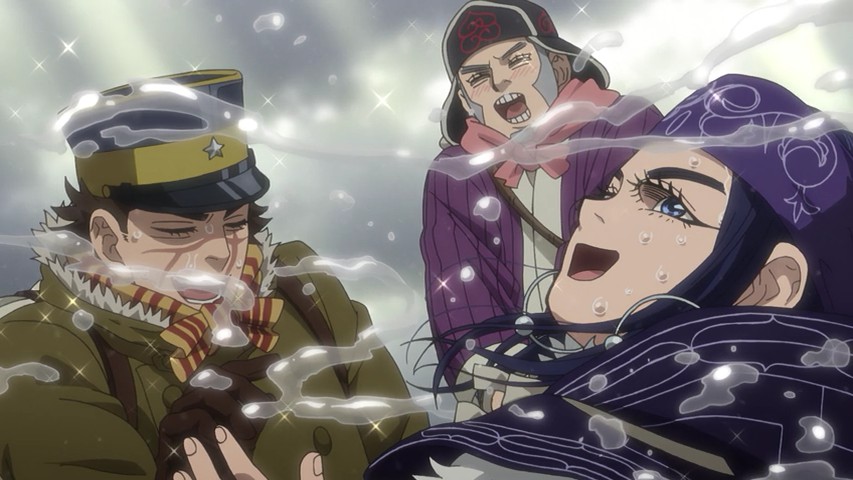





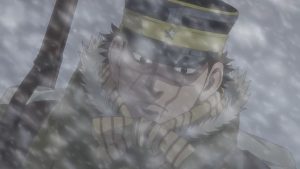
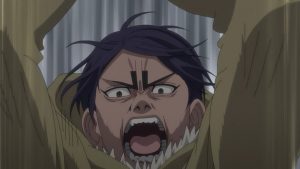

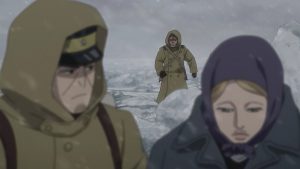


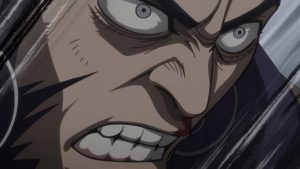
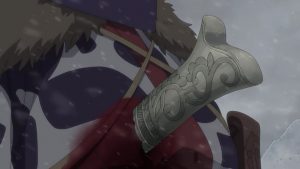
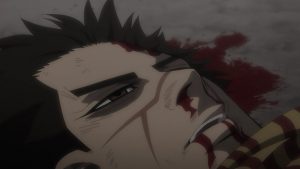


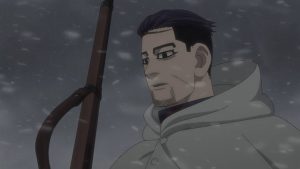
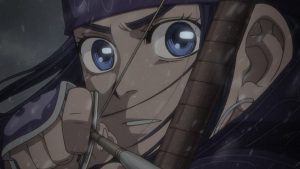


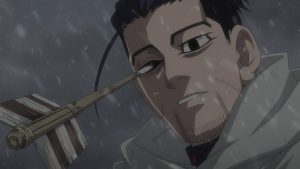


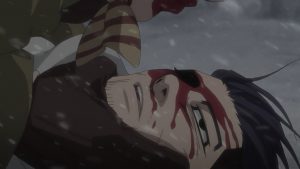

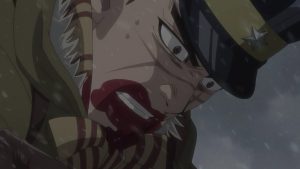
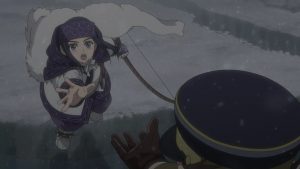
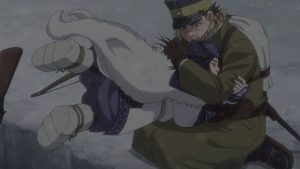



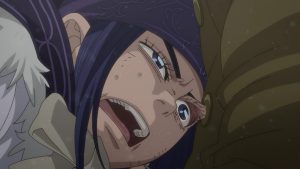


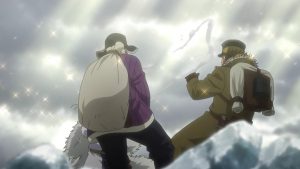


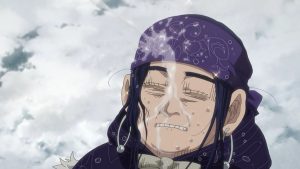



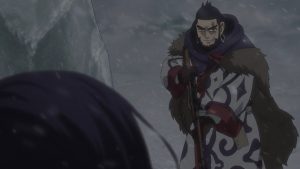
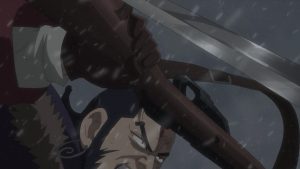
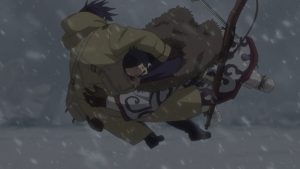
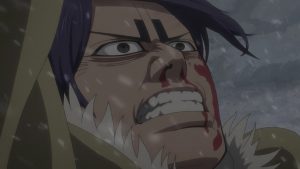
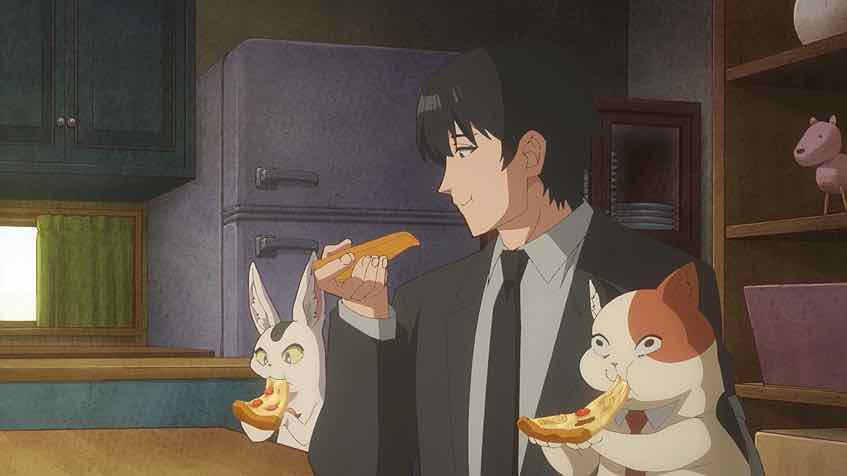
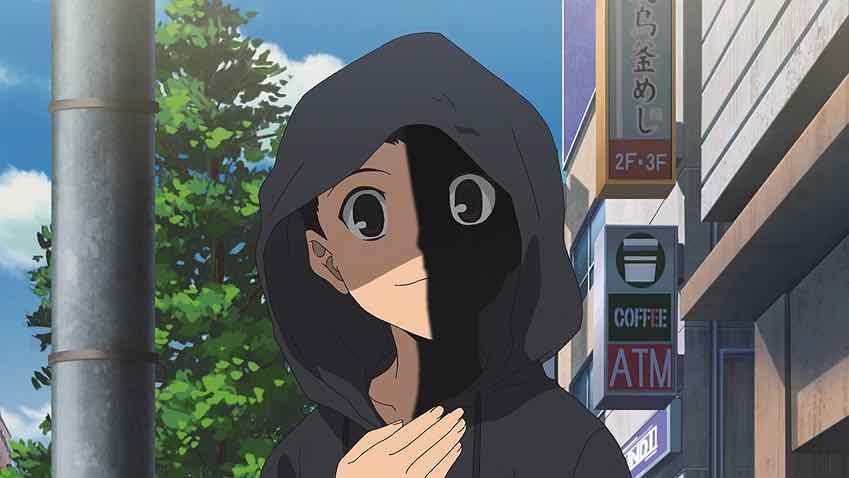
sweejen
December 15, 2020 at 11:41 pmThe best thing about Golden Kamuy (in a long list) is that I feel equally satisfied whether my expectations are subverted or fulfilled. Knowing exactly what’s going to happen, like in the pee scene, seems like a little reward for knowing the characters so well. For all its craziness, I’m in awe of the control Noda has over this story!
Red
December 16, 2020 at 10:49 amGraphic and wholesome, tense atmosphere and then carefree in another scene, life and death situations coupled with toilet humor, I only have praise, one more episode to finish the year!
Guardian Enzo
December 16, 2020 at 7:06 pmIt really is a unique piece of work.
ibtachi
December 18, 2020 at 2:52 amI cannot believe I went from being on the verge of welling up to laughing my *** off within the span of a minute.
All I can say is Kudos to both Noda, and the team that brought this to life.
Yes
December 20, 2020 at 1:43 amThat was the great scene of anime ever made. Nothing will ever surpass it, not even if they spent 1B per minute